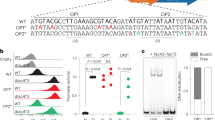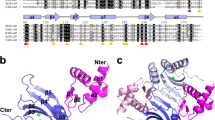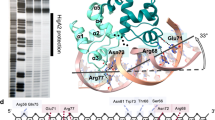Abstract
The diphtheria tox represser, DtxR, is a 226 amino acid transition metal ion-activated regulatory protein that controls the expression of diphtheria toxin in toxigenic Corynebacterium diphtheriae. The previously solved three-dimensional DtxR structures have identified two potential metal ion binding sites which may play a role in the activation of DNA binding by the represser. We have used both X-ray crystallographic and site-directed mutational analysis of DtxR(C102D)–Ni2+ complexes and DtxR to identify the metal ion-binding site which results in the activation of the repressor. We demonstrate that DtxR contains both a primary and an ancillary metal ion binding site. The primary site functions directly in the activation of DNA binding. In contrast, the ancillary site contributes weakly, if at all, to activation.
This is a preview of subscription content, access via your institution
Access options
Subscribe to this journal
Receive 12 print issues and online access
$189.00 per year
only $15.75 per issue
Buy this article
- Purchase on Springer Link
- Instant access to full article PDF
Prices may be subject to local taxes which are calculated during checkout
Similar content being viewed by others
References
Tao, X., Schiering, N., Zeng, H., Ringe, D. & Murphy, J.R. Iron, DtxR, and the regulation of diphtheria toxin expression. Molec. Microbiol. 14, 191–197 (1994).
Pappenheimer, A.M., Jr. The pathogenesis of diphtheria. Symp. Soc. Gen. Microbiol., 40–56 (1955).
Uchida, T., Gill, D.M. & Pappenheimer, A.M., Jr. Mutation in the structural gene for diphtheria toxin carried by temperate phage β. Nature 233, 8–11 (1971).
Buck, G.A., Gross, R.E., Wong, T.P., Lorea, T. & Groman, N.B. DNA relationships among some tox-bearing corynebacteriophages. Infect. Immun. 49, 679–684 (1985).
Boyd, J., Oza, M. & Murphy, J.R. Molecular cloning and DNA sequence analysis of an iron dependent diphtheria tox regluatory element (dtxR) from Corynebacterium diphtherias . Proc. Natl. Acad. Sci. USA 87, 5968–5972 (1990).
Schmitt, M.P. & Holmes, R.K. Iron-dependent regulation of diphtheria toxin and siderophores expression by the cloned Corynebacterium diphtheriae represser gene dtxR in C. diphtheriae . Infect. Immun. 59, 1899–1904 (1991).
Tao, X., Boyd, J. & Murphy, J.R. Specific binding of the diphtheria tox regulatory element DtxR to the tox operator requires divalent cations and a 9-base-pair interrupted palindromic sequence. Proc. Natl. Acad. Sci. USA 89, 5897–5901 (1992).
Schmitt, M.P. & Holmes, R.K. Analysis of diphtheria toxin repressoroperator interactions and characterization of a mutant represser with decreased binding activity for divalent matals. Mol. Microbiol. 9, 173–181 (1993).
Tao, X. & Murphy, J.R. Determination of the DtxR consensus binding site by in vitro affinity selection. Proc. Natl. Acad. Sci. USA 91, 9646–9650 (1994).
Qiu, X. et al. Three-dimensional structure of the diphtheria toxin represser in complex with divalent cation corepressors. Structure 3, 87–100 (1995).
Schiering, N. et al. Structures of the apo- and the metal ion activated forms of the diphtheria tox represser from Corynebacterium diphtheriae. Proc. Natl. Acad. Sci. USA 92, 9843–9850 (1995).
Wang, Z., Schmitt, M.P. & Holmes, R.K. Characterization of mutations that inactivate the diphtheria toxin represser (dtxR) . Infect. Immun. 62, 1600–1608 (1994).
Tao, X., Zeng, H. & Murphy, J.R. Transition metal ion activation of DNA binding by the diphtheria tox represser requires the formation of stable homodimers. Proc. Natl. Acad. Sci. USA 92, 6803–6807 (1995).
Tao, X. & Murphy, J.R. Cysteine-102 is positioned in the metal ion activation site of the Corynebacterium diphtheriae regulatory element DtxR. Proc. Natl. Acad. Sci. USA 90, 8524–8528 (1993).
Sanger, F., Nicklen, S. & Coulsen, A.R. DNA sequencing with with chain terminating inhibitors. Proc. Natl. Acad. Sci. USA 74, 5463–5467 (1977).
Kraft, R., Tardiff, J., Krauter, K.S. & Leinwand, L.A. Using mini-prep plasmid DNA for sequencing double stranded template with sequenase. BioTechniques 6, 544–547 (1988).
Miller, J.H. Experiments in Molecular Genetics (Cold Spring Harbor Laboratory, Cold Spring Harbor, New York, 1972)
Putnam, S.L. & Koch, A.L. Complications in the simplest cellular assay: Lysis of Escherichia coli for the assay of β-galactosidase. Anal. Biochem. 63, 350–360 (1975).
Brünger, A.T., Karplus, M. & Kuriyan, J. Crystallographic R-factor refinement by molecular dynamics. Science 235, 458–460 (1987).
Brünger, A.T. Crystallographic refinement by simulate annealing: application to a 2.8Å resolution structure of aspartate aminotransferase. J. Mol. Biol. 203, 803–816 (1988).
Jones, T.A., Zou, J.Y., Cowan, S.W. & Kjeldgaard. Improved methods for building protein models in electron density maps and the location of errors in these models. Acta Crystallogr. A47, 110–119 (1991).
Author information
Authors and Affiliations
Rights and permissions
About this article
Cite this article
Ding, X., Zeng, H., Schiering, N. et al. Identification of the primary metal ion-activation sites of the diphtheria tox represser by X-ray crystallography and site-directed mutational analysis. Nat Struct Mol Biol 3, 382–387 (1996). https://doi.org/10.1038/nsb0496-382
Received:
Accepted:
Issue Date:
DOI: https://doi.org/10.1038/nsb0496-382



